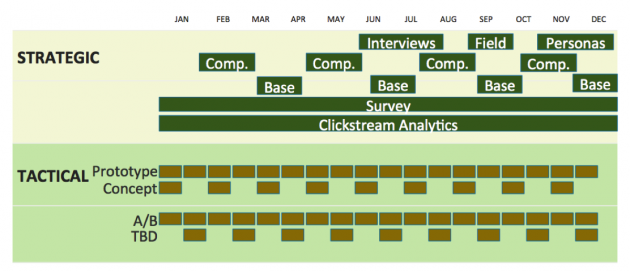
Recently, I presented a talk, UX Research = UX Innovation, at the Forge Conference in Philadelphia, PA. The talk focused on the top five themes that I’ve been talking about with UserTesting customers over the past several months as I have been working with them to build out their research programs.
1. Contextual basic research should be a part of your UX research program
Basic research is typically defined as study directed today understanding the fundamental aspects of phenomena without a specific application in mind. For example, scientists engage in this type of research to understand things like the nature of matter versus energy or the properties of water. Sometime in the future, this information becomes meaningful as we discover how to use it in a practical setting, but basically, we spend time working toward understanding it because it helps us understand more about how the world or our environment works—and that enriches our knowledge base so that when the time is ripe, we can apply that awareness.
From a UX perspective, I think that researchers must understand their users’ landscape—their needs, thoughts, preferences, and experiences—without a plan for how that information might be used. You should be conducting qualitative research that helps you to build empathy with users without having a specific application in mind.
This is one type of strategic research.
It goes beyond figuring out how to build something and what people prefer and expect. Instead, you are building empathy for users by learning about how they live and what they do. When the time is right, you can rely on that information as a starting point as it gives you a sense of where the opportunities are—and therefore, an awareness of what you might build to address real needs.
2. Strategic and tactical research must be balanced
This means that you need to set aside time to engage in this type of research. Planning must be intentional because most organizations have cyclical calendars and a set amount of resources.
Many researchers only get to do tactical research, and this is understandable based on the history of usability and user experience research. Because we have focused on solving the problems of getting people to successfully and efficiently complete tasks, we don’t always budget the resources to focus beyond testing wireframes or concepts, or optimizing sites. But we can—and should—spend some time doing research at that strategic level so that when we don’t have the time to do the research given a short timeframe or limited resources, we know what to do because we have built empathy with our users; we know what they need, want, and expect.
When you are planning, think about the volume of research you can conduct, the planned projects on your horizon, and the UX research deliverables you think will best represent what you have learned. By taking inventory of what lies before you, you can make choices about what you can do when. If you are running in an Agile environment, it would look a little something like this:

If you really don’t have that much visibility into what the plans are or what the future holds, at least put together a plan that speaks to what you are capable of doing. That way, when projects come to light, you will have the ability to queue them up and set expectations with your team about what you can provide to them and when.
3. Look for the unexpected and the unexplained
When we look at problems, we often focus on answering the issue that is right in front of us. We listen to what users say and take their word for it. We look at what they do and come to conclusions based on that behavior.
However, some of the best moments of discovery I have had have come out of surprises or seeing things I didn’t expect. For example, look at this picture:

For the purposes of the presentation, I was searching for a picture that would show desire lines—essentially, a social trail or pathway created people or animals outside—and happened upon this picture of the University of Michigan Law Quad on a snowy February day.
Typically, when you see pictures of desire lines, it’s clear why they have been created because they tend to be shortcuts or avoid clearly visible barriers in the normal path. However, when I look at this picture, I see a path in cold, wet, heavy snow that isn’t more convenient than the sidewalk. I imagine myself trudging through that mess when there are paved and clear pathways very close to me – and there isn’t a door waiting for me at the other either end of this path. Why did people walk that way?
We don’t see this frequently enough when we look at analytics. It might be that 75% of people start at the homepage, hit a category page, and go straight to a product detail page. But what did the other 25% do? Why? What can we learn from that behavior?
This is why I am so passionate about qualitative research; when we figure out why something is happening, we can figure out what we need to do to alter or better support that behavior.
4. Test risky concepts early and iteratively
UX designers and researchers know that the earlier and more frequently we can get feedback during a project, the better.
I got an interesting question at the end of the talk that speaks to a fear that we have about doing research: What if we learn that users hate what we have created?
My thought is that you can’t give up just because users hate it. You need to persist, to understand why they hate it to know what you need to do to fix it. Maybe it does mean starting over. But if you’re testing something risky early and often enough, you’re giving yourself a better chance of getting the right thing released—and having people love it.
5. Building a UX research program requires time and resources
In a perfect world, we would have unlimited time and money to learn what we need, build, test it, and run it effectively. The reality we live in is messy, inelegant, and challenging. You can only do as much UX research and intentional design as your organization is ready for and able to support. The plan above is not something that a UX team of one is going to be able to support, but a team including several members would.
The reality is also that many of us work in settings where UX is not part of the DNA of the organization. While the world is evolving as most companies are realizing that they must compete on the basis of customer experience—which, at its core, is grounded in UX—it’s still exceptional to find businesses where everyone from the CEO on down is driven by that focus on optimizing the customer experience.
That means that you can only accomplish what you can given the resources you have, so it is important to start with what will make the greatest impact that you can pull off. Often, that point of impact is getting wireframes in front of users early. As you experience and share successes as a result of leveraging user feedback, you can build the momentum to grow your team—and do more research across the discovery and optimization parts of the design and build product lifecycle and share what you learn across your organization more broadly.
As your team and the impact of your work grows, you can add to the suite of activities that you support. Maybe you add optimization exercises or competitive benchmarking to see how you measure up with other sites in the space. Then, perhaps you undertake some omnichannel projects to understand how people interact with your organization across time and channel.
Bottom line, doing what you can when it makes sense to help your organization make better decisions is a delicate balancing act. Planning can help you to add depth and reach to your UX research practice.
Insights that drive innovation
Get our best human insight resources delivered right to your inbox every month. As a bonus, we'll send you our latest industry report: When business is human, insights drive innovation.






